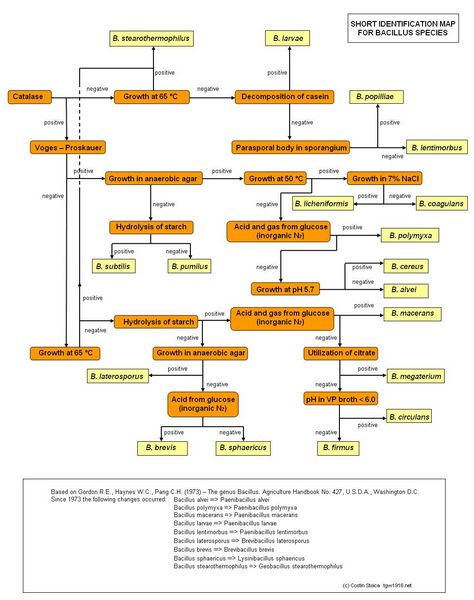General Considerations
Bacillus species other than B anthracis are found in soil, decaying organic matter, and water, but they are rare causes of disease. Risk factors associated with Bacillus infection include the presence of intravascular catheters, intravenous drug use, sickle cell disease, and immunosuppression — particularly corticosteroid use, transplantation, AIDS, and neutropenia secondary to chemotherapy. The hardy growth characteristics of Bacillus spp. cause them to arise as common laboratory contaminants; however, they are also capable of causing severe invasive illness.

B cereus and B subtilis are the most frequent Bacillus spp. to cause invasive infection. Pneumonia, meningoencephalitis, endocarditis (native and prosthetic valves), and intravascular catheter infection have been well described. High-grade bacteremia with B cereus can be seen in the presence of indwelling intravenous catheters and always necessitates the removal of the catheter along with appropriate antimicrobial therapy. B cereus also causes soft-tissue and bone infections, including necrotizing fasciitis, particularly after contamination of wounds by soil. The characteristics of diseases associated with Bacillus spp. are indistinguishable from those associated with other pyogenic bacteria, and diagnosis depends on culture data.
Clinical Findings
B cereus accounts for 1-3% of all foodborne disease reported in the United States, although 10-14% of humans are colonized by this organism in their intestinal tract. There are two clinical syndromes associated with ingestion of this organism, an emetic and a diarrheal syndrome. The emetic syndrome is characterized by a short incubation period (1-6 h). Patients present with vomiting and abdominal cramping. The emetic syndrome is usually associated with ingestion of contaminated cooked rice and is caused by a preformed, heat-resistant 5- to 10-kDa emetic toxin. The diarrheal syndrome has a longer incubation period (6-14 h), and it is characterized by watery diarrhea, abdominal cramping, and, less commonly, by vomiting. The diarrheal syndrome is associated with ingestion of contaminated vegetables, sauces, and puddings, and it is attributed to at least two heat-labile enterotoxins produced by B cereus. The durations of illness are 2-10 h for the emetic syndrome and 16-48 h for the diarrheal syndrome. The symptoms in both syndromes are self-limited, and supportive care only is necessary. Outbreaks of foodborne illness caused by B subtilis, B licheniformis, and B pumilus have also been reported.
B cereus is also a major cause of ocular infections such as endophthalmitis after eye trauma, and it is often associated with intraocular foreign bodies. The onset of infection is rapid, leading to destruction of the vitreous and retinal tissue with subsequent loss of vision within 12-48 h. Panophthalmitis and endophthalmitis with B cereus have also been described in injection drug abusers, without ocular trauma.
Treatment
B cereus is resistant to penicillin and other beta-lactam drugs, including cephalosporins. Active antimicrobial agents include vancomycin, clindamycin, aminoglycosides, carbapenems, and ciprofloxacin. Non-B cereus spp. are susceptible to penicillin and cephalosporins. Appropriate empiric therapy for suspected Bacillus spp. infections (other than anthrax) is vancomycin or clindamycin, with or without an aminoglycoside. Intraocular infections require aggressive therapy with systemic antibiotics plus intravitreous clindamycin or an aminoglycoside. Intravitreous dexamethasone and early vitrectomy are also recommended for sight-threatening B cereus ocular infection.




